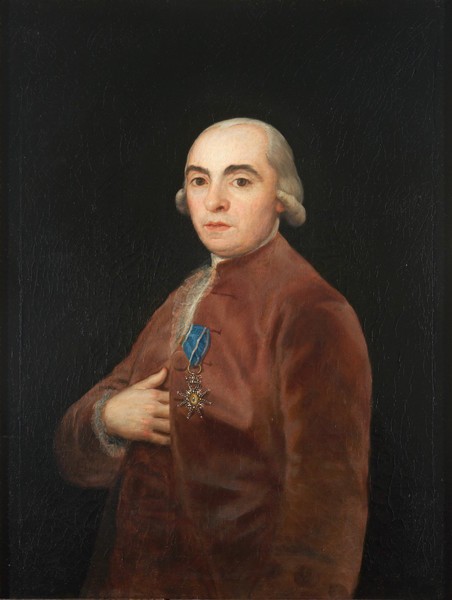- Cronología
- 1790
- Ubicación
- Museum of Zaragoza, Zaragoza, Spain
- Dimensiones
- 84 x 65 cm
- Técnica y soporte
- Oil on canvas
- Reconocimiento de la autoría de Goya
- Documented work
- Titular
- Government of Aragon
- Ficha: realización/revisión
- 11 Feb 2010 / 11 Dec 2024
- Inventario
- (54359)
This painting belonged to the family of the sitter, who possessed several works by Goya. Through successive marriages and inheritances it has been the property of the Counts and Countesses of Sobradiel, Gabarda, and Orgaz and the Marquises of Las Palmas. In 1997 it was acquired by the Government of Aragón through Sotheby's for the Museum of Zaragoza.
From December 5th, 2024, and while the Zaragoza Museum remains closed for works, the painting is part of the exhibition 'Goya. From the Museum to the Palace' in the Aljafería Palace in Zaragoza.
Juan Martín de Goicoechea y Galarza Ziordia y Albizu (Bacaicoa, Navarre, 1732-Zaragoza, 1806) was one of Goya's best friends in Zaragoza. After finishing his studies in this city he moved to Lyon, where he studied commerce and learned the art of manufacturing silk. In 1772, upon returning to Zaragoza, he founded his own factory and soon became the most important trader and businessman in the city. A liberal and ilustrado, he was a founding member of Aragón's Royal Economic Society of Friends of the Country and maintained, at his own expense, a Drawing School created by that institution which was active from 1784 to 1792, the year in which the San Luis Royal Academy of Fine Arts was created. In 1789 he was awarded the minor Cross of the Royal Order of Charles III.
The half-length image of the subject is shown against a black background. The figure, in half profile, is looking straight out at the viewer. He is dressed in a brown dress coat, from which the cross of the Royal Order of Charles III hangs. His right hand is partially concealed within the coat, to one side of the decoration.
The pale skin tones of the figure's face and hand stand out in sharp contrast with the deep, uniform black of the background. After the work was cleaned in 2008, the subtle velvet qualities of the coat became evident, as well as the deftly painted sheer lace poking out from underneath at the cuffs and shirt front.
Goya would have been able to make studies for this portrait from life during the 23 days in October 1790 in which he was in Zaragoza, although the work would have actually been finished in Madrid in December of that same year.
The Aragonese Royal Economic Society of Friends of the Country possesses a version of this portrait, which has led to various hypotheses about its authorship and date. Everything seems to indicate that the other work is a copy by an unknown artist and not the portrait that this institution commissioned from the painter Juan Andrés (Merclein?) in 1787, since its style differs considerably from other works known to be by this artist.
Cleaned in 2008.
-
Exposición Hispano-FrancesaZaragoza1908
-
Exposición de obras de Goya y de objetos que recuerdan las manufacturas artísticas de su épocaMuseo de ZaragozaZaragoza1928organized by la Real Academia de Nobles y Bellas Artes de San Luis in collaboration with the Junta del Patronato del Museo Provincial. April 1928
-
Goya (1746 – 1828)Galleria Internazionale d’Arte Moderna di Ca’PesaroVenecia1989consultant editor Antonio Fortún Paesa. From May 7th to July 4th 1989cat. 26
-
GoyaLa Lonja, Torreón Fortea y Museo Pablo GargalloZaragoza1992consultant editor Julián Gállegocat. 18
-
La memoria de GoyaMuseo de ZaragozaZaragoza2008organized by Fundación Goya en Aragón, consultant editor Juan Carlos Lozano López. From February 7th to April 6th 2008cat. 38
-
Goya e ItaliaMuseo de ZaragozaZaragoza2008organized by the Fundación Goya en Aragóna, consultant editor Joan Sureda Pons. From June 1st to September 15th 2008cat. 258
-
Goya y el Mundo ModernoMuseo de ZaragozaZaragoza2008organized by the Fundación Goya en Aragón at the Museo de Zaragoza, consultant editors Valeriano Bozal and Concepción Lomba Serrano. From December 18th 2008 to March 22nd 2009cat. 1
-
Goya e il Mondo ModernoPalazzo RealeMilan2010organized by SEACEX, Palazzo Reale and Fundación Goya en Aragón, consultant editors Valeriano Bozal and Concepción Lomba Serrano. From March 17th to June 27th 2010cat. 3
-
Goya. From the Museum to the PalaceZaragoza2024cat.123
-
Vie et ouvre de Francisco de GoyaParísOffice du livre1970p. 98, cat. 277
-
Juan Martín de Goicoechea y Galarza”Goya 1746-1828Milan1989pp. 108-109
-
“Juan Martín de Goicoechea”GoyaZaragozaEd. Electa y Ayuntamiento de Zaragoza1992pp. 64-65
-
Goya y Aragón. Familia, amistades y encargos artísticoscol. Col. Mariano de Pano y RuataZaragozaCaja de Ahorros de la Inmaculada de Aragón1995pp.160-164 (il)
-
La memoria de Goya (1828 – 1978)ZaragozaGobierno de Aragón, Dpto. de Educación, Cultura y Deporte2008p. 329, cat. 38
-
Goya e Italia, 2 vols.ZaragozaFundación Goya en Aragón y Turner2008vol. II, pp.293-294 (il.), cat. 258
-
Goya. From the Museum to the PalaceZaragozaZitro Comunicación2024pp.122-123
